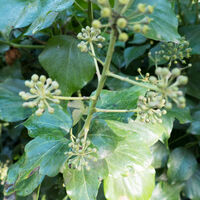ivies
genus Hedera
Member of
ivy family (family Araliaceae)
dicots (class Magnoliopsida)
flowering plants (subphylum Angiospermae)
There are no other wild species of this genus in California.
Juvenile stems are slender, flexible, and climbing with the aid of small aerial roots, and their leaves are often lobed. Adult leaves are thicker, self-supporting, without roots, and non-climbing (instead lying or twining at whatever level the juvenile stems reached), and their leaves are ± entire.
canary islands ivy
Hedera canariensis
- leaves on juvenile stems: ≤ 25 cm, unlobed to shallowly 3-lobed, lobes rounded to acute
- hair stellate, red-orange, hair rays appressed
See also cape-ivy (Delairea odorata).
Toxicity of ivy (Hedera spp.):
1 – Skin contact with these plants can cause symptoms ranging from redness, itching, and rash to painful blisters like skin burns.
3 – Ingestion of these plants is expected to cause nausea, vomiting, diarrhea and other symptoms that may cause illness but is not life-threatening.
At least one lower-level taxon has differing toxicity.
1 observed taxon / 1 unobserved taxon / 1 key
Locations: Months: For more details, use advanced search.
Chris’s observations: 10 (3 are research grade)
Not all sites include this taxon:
- genus Hedera → iNaturalist – Calflora – Jepson eFlora
- not yet listed → FNA
Bay Area species: iNaturalist – Calflora
